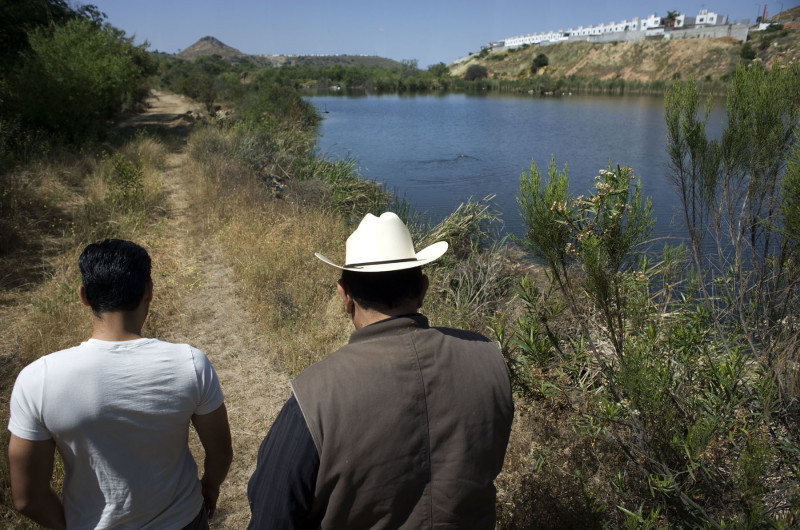In many ways, Rancho Ontiveros embodies the history and the future of the Cali-Baja megaregion.
The vast property, just under twice the size of the San Diego Zoo Safari Park, sits right on the border of Tijuana and San Diego County – the edge touched by the border fence and just a few minutes’ drive from where a new border crossing will be built in the next several years.
The Tecate River, part of the Tijuana River watershed, flows through the property from north of the border in Otay, before going west and eventually ending up in Imperial Beach.
Undocumented migrants headed to the U.S. frequently cross through the property.
The property owners’ offices are in Otay Mesa, just 10 minutes away. Underneath their office, networks of drug tunnels have been found over the past decade.
And though President Donald Trump is moving forward with plans for a border wall – a literal barricade dividing the U.S. and Mexico – the vision for the property strives to connect Tijuana and San Diego even more by becoming a hub for where people from both sides of the border can live and work.
The plans include moderate-priced housing meant for both San Diegans and Tijuanenses. They include industrial space for Tijuana’s manufacturing industry, which developed in part because of its proximity to the U.S., as well as expansive green space and nature preserves, something lacking in Tijuana and influenced by the efforts to conserve such spaces on the other side of the border.
Even the family members who own and are now developing the property have lived lives only possible at the border.
Ana Nevarez and her brother Francisco Ontiveros are two of five children of the late Pantaleon Ontiveros, who originally purchased the property and who passed away in 1998.
Francisco Ontiveros used to cross the border every day to attend Sweetwater High School. Nevarez attended San Diego High. She now lives in Chula Vista with her children. Ontiveros lives in Baja California.
“The property is in the heart of the region,” Nevarez said. “To me the most important thing is the region. In the current time, in the United States and Mexico, we have a division, but you don’t really see that division in a materialistic way. The line is all in one region.”
Ontiveros and Nevarez have a mission: to bring a different kind of development to Tijuana.
It was their father’s vision years ago. But it’s also representative of their binational lifestyles.
Tijuana developed haphazardly. People bought land and built, without larger visions for the city’s design and what should be included to improve the quality of life for its residents.
“We don’t want more of the same,” Ontiveros said in Spanish. “The base is my father’s vision. But we can say that there has been an influence in how to plan and develop from our time in the U.S.”
The vision for the property and its strategic location on the border is what drew Gabriel Andres Garzo, the developer working with the family, to the property.
“I would go from one of the more affluent parts of San Diego to Tijuana, and there were these significant changes in urban form,” Garzo said. “But it’s right next door. So one of the things Ana said at the beginning – I’ve been here now since 2003 – is, ‘Why can’t we do something better over here? Why is it just because you cross the border, you can’t have world-class planning and development?’”
Pantaleon Ontiveros purchased the property in 1948. At the time, it was so far east from the core of Tijuana that no development or people were nearby. The first thing he built was a ranch in the early 1960s that is still used by the family. Around 1972, he drew up a master plan for the property, which is framed in the Otay Mesa office and continues to be the inspiration for the development.
“I think the first thing that my dad saw was the geography of the site,” Nevarez said. “North of the property was the United States, west of the property was the ocean, so we have a city that could not grow to the west, that could not grow to the north. It can only grow to the east or the south. Our father saw clearly that in the near future, the area would be absorbed by the city.”
In the late 1980s and early 1990s, Baja California started building the Tijuana-Tecate highway – straight through the property. When the highway came online, the family knew it was time to start developing.
“There’s no more land in Tijuana until Rancho Ontiveros,” said Francisco Ontiveros.
Tijuana has been one of the fastest-growing metros in Mexico for decades, and the rapid growth is expected to continue.
One of the reasons it’s grown so quickly is because of its proximity to Southern California, said Paul Ganster, director of the Institute for Regional Studies of the Californias at San Diego State University.
“Southern California has had an insatiable demand for labor since World War II,” Ganster said.
Tijuana’s maquiladora industry – factories that manufacture and assemble products – also created a steady source of jobs in the area.
“People from all over Mexico know they can come to Tijuana and find a job and possibly get access to the U.S., either formally or informally,” Ganster said.
The family intends on preserving roughly 1,000 acres, or just under half of the property as open space, including a lake and trails with public access. Tijuana doesn’t have much usable green space, said Ontiveros.
Ontiveros, the only son in the family, remembers taking care of the vast agricultural property with his father before development started encroaching eastward in Tijuana. Working the fields, herding cattle and hunting on the property instilled in him a love for nature that he hopes to preserve through planned development.
The first 375 acres of the property that will be developed over the next couple of years will also include upwards of 600 homes in the northern portion of the project. The single-family homes will run in the $150,000 to $200,000 price range – something that is missing in the housing market on both sides of the border.
San Diego needs to produce more than 160,000 homes between 2010 and 2020. As of 2014, the region produced only 31 percent of the high-income units needed, 4 percent of the moderate-income units needed and 6 percent of the low-income units needed, according to a report from the San Diego Housing Commission.
Tijuana has also fallen short of meeting its housing needs. In 2016, only 8,400 homes of the roughly 13,400 needed were built, according to CANADEVI, the National Chamber for Housing Development & Promotion.
The Tijuana-Tecate highway runs through the property and the new, planned Otay II Port of Entry that CalTrans hopes will be finished in 2022 will be five minutes away from the homes, allowing commuters easy access to Tijuana’s urban core and to jobs in San Diego.
The development will also include industrial development, a school and a denser mixed-use town center, condos and commercial development.
Parts of the property are already housing people. In 2010, Tijuana was struggling over where to house large numbers of its poor residents who were displaced after strong rains and flooding.
The family and Garzo struck a deal with the city to help provide housing for them. They put in the land at a low rental cost. The city put in infrastructure, like water and electricity, and gave vouchers to the people in need of housing to buy the construction materials to build their homes.
Those people are still living in the development, Vallecito Majestad, and Garzo said they are working with the city to do a second phase for the colonia, but in a more planned, less reactionary way.
The site’s location on the eastern edge of Tijuana worries some binational urbanists that it could be a continuation of Tijuana’s sprawl. That’s one of the concerns of Lawrence Herzog, a professor of urban planning at San Diego State University.
“I’ve been trying to promote the idea of a cross-border metropolis,” Herzog said. “But the infrastructure has to be smart about how to create those connections. We need good, sustainable cross-border development.”
Herzog said he agrees with the Garzo, Ontiveros and Nevarez that the way Tijuana has developed until now hasn’t been the smartest, but he has concerns about developments that increase car trips into Tijuana’s urban core and into San Diego, rather than densifying areas to facilitate public transit use.
But as long as it is planned well, Herzog said developments like Rancho Ontiveros can play unifying roles in the region and embody the distinction between current national rhetoric about the border and the reality on the ground.
“The border is an everyday space where people cross, and here’s a developer who just wants to build things for everyone,” he said.
The family and Garzo aren’t worried that the nationalist rhetoric from Trump will hurt the project.
“Housing is a local issue,” Garzo said. “The market forces on the residential side that we see are here to stay. You have policy forces in California that have created a very unaffordable environment.”
Industrial development is more tied to U.S. trade policies, like the North American Free Trade Agreement, which Trump threatened to pull the U.S. out of during his campaign.
Tijuana has become a high-tech manufacturing hub for items like medical devices and electronics, said James Gerber, an economics professor at San Diego State University.
“Things were put on hold after the election, and a lot of businesses have been waiting to see the policies of the Trump administration toward Mexico and border control,” Gerber said.
But now, he said, many people think U.S.-Mexico relations will overcome the divisive rhetoric.
“The reality is that we are enjoined at the hip,” he said. “We don’t know what’s going to happen, but I just think the reality will force them to limit the policies.”
Even if the U.S. changes its trade policies with Mexico, Nevarez said she thinks they won’t have problems finding interest in the industrial portions of the development.
“For us, nothing changes,” she said. “The maquiladoras will either be from the U.S. or from the next country ready to sign a free trade agreement with Mexico.”
The Trump administration’s rhetoric does bother them, though.
“It’s the politics of it,” Garzo said.” “It’s the tone he’s presenting. For example, we don’t have an issue with increased border security, but an asinine border wall doesn’t help security.”
Ontiveros agreed, and said nothing has changed when it comes to people sneaking through their property to get to the U.S. The border fence sits on the edge of their property.
“People throw a rope and climb,” he said. “They find a way.”
If authorities really cared about stopping illegal migrants, Garzo said, they could come talk to those who own property along the border, like Rancho Ontiveros.
“U.S.-Mexico relations shouldn’t be a partisan issue,” Garzo said. “We’re the de facto laboratory for how U.S.-Mexico relations should be here in San Diego-Tijuana.”





